| And Other Tales | |
|---|---|
 Cover by Jennell Jaquays [lower-alpha 1] | |
| Designers | |
| Publishers | Judges Guild |
| Publication | 1980 |
| Genres | Fantasy |
| Systems | Basic Role-Playing |
Legendary Duck Tower is a 1980 fantasy role-playing game adventure published by Judges Guild.
| And Other Tales | |
|---|---|
 Cover by Jennell Jaquays [lower-alpha 1] | |
| Designers | |
| Publishers | Judges Guild |
| Publication | 1980 |
| Genres | Fantasy |
| Systems | Basic Role-Playing |
Legendary Duck Tower is a 1980 fantasy role-playing game adventure published by Judges Guild.
Duck Tower is an adventure in a dungeon with a hundred rooms. [1] Characters can encounter 61 different creatures. [1]
The scenario is set in a citadel in ruins that was once populated by humanoid ducks. [2] The book contains dozens of non-player characters. [2] The gamemaster can decide where to place the encounters. [2]
The book describes both an abandoned city and tower. [3] The NPCs each have short paragraphs to describe their personalities and motives. [3] The dungeon has detailed descriptions and several maps and diagrams, with a list of random items that players can find. [3]
The ruined fortress-temple of the god Humakt is home to 17 groups of NPCs and monsters. [4] The prosperous duck tribe that lived there when it fell centuries ago are a mutated or cursed race of humanoids. [4] It has been taken over by explorers, outlaws, dangerous creatures, and archeologists. [4] The gamemaster rolls a 100-sided die to assign a location for each encounter. [4] One map without a grid pattern shows the entire Duck Tower complex, and the gamemaster shows the players a sketch of what is visible as the party comes near the temple. [4]
Legendary Duck Tower and Other Tales was written by Jennell Jaquays [lower-alpha 1] and Rudy Kraft, and was published by Judges Guild in 1980 as a 64-page book. [2]
Both the title and cover of the module reference the Dark Tower adventure also by Jaquays. [2]
It is a supplement for RuneQuest for two or more players. [1]
Forrest Johnson, in The Space Gamer #29, commented that "Duck Tower is a wonder and a marvel, a priceless adventure for anyone who likes Runequest ." [1]
William Fawcett, in issue #44 of The Dragon , commented that "One of the weaknesses of many Runequest scenarios is that they sacrifice detail in the environment and dungeons, in favor of presenting the details of the statistics of a large number of non-player characters. [Duck Tower] is exceptional in that it not only avoids this problem, but does a very good job of presenting an interesting locale for adventuring in any system. This is definitely one of the best Runequest scenarios available and should be a must for anyone campaigning in the system." [3]
Anders Swenson reviewed Duck Tower for Different Worlds magazine and stated that "The concept is one which should be applicable to many individually-written adventures, the found magical items are a new dimension to the game (there are no 'standard' RQ magic items in the tower as written) and overall it is a good investment for all RQ campaign referees." [4]

A gamemaster is a person who acts as an organizer, officiant for regarding rules, arbitrator, and moderator for a multiplayer role-playing game. They are more common in co-operative games in which players work together than in competitive games in which players oppose each other. The act performed by a gamemaster is sometimes referred to as "Gamemastering" or simply "GM-ing".

RuneQuest is a fantasy tabletop role-playing game originally designed by Steve Perrin, Ray Turney, Steve Henderson, and Warren James, and set in Greg Stafford's mythical world of Glorantha. It was first published in 1978 by The Chaosium. Beginning in 1984, publication passed between a number of companies, including Avalon Hill, Mongoose Publishing, and The Design Mechanism, before finally returning to Chaosium in 2016. RuneQuest is notable for its system, designed around percentile dice and an early implementation of skill rules, which became the basis for numerous other games. There have been several editions of the game.

Expedition to the Barrier Peaks is a 1980 adventure module for the Advanced Dungeons & Dragons role-playing game written by Gary Gygax. While Dungeons & Dragons (D&D) is typically a fantasy game, the adventure includes elements of science fiction, and thus belongs to the science fantasy genre. It takes place on a downed spaceship; the ship's crew has died of an unspecified disease, but functioning robots and strange creatures still inhabit the ship. The player characters fight monsters and robots, and gather the futuristic weapons and colored access cards that are necessary for advancing the story.

The Isle of Dread is an adventure for the Dungeons & Dragons role-playing game. The adventure, module code X1, was originally published in 1981. Written by David "Zeb" Cook and Tom Moldvay, it is among the most widely circulated of all Dungeons & Dragons adventures due to its inclusion as part of the D&D Expert Set. In the adventure, the player characters search for a lost treasure, journey to the prehistoric Isle of Dread, and there meet new nonhuman races.
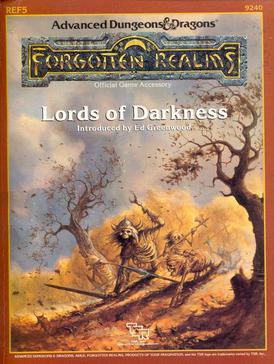
Lords of Darkness is the name of two accessories for the fictional Forgotten Realms campaign setting for the Dungeons & Dragons fantasy role-playing game.

Jennell Jaquays is an American game designer, video game artist, and illustrator of tabletop role-playing games (RPGs). Her notable works include the Dungeons & Dragons modules Dark Tower and Caverns of Thracia for Judges Guild; the development and design of conversions on games such as Pac-Man and Donkey Kong for Coleco's home arcade video game system; and more recent design work, including the Age of Empires series, Quake 2, and Quake III Arena. One of her best known works as a fantasy artist is the cover illustration for TSR's Dragon Mountain adventure.

Dark Tower is an adventure module published by Judges Guild in 1980 for the Advanced Dungeons & Dragons fantasy role-playing game.
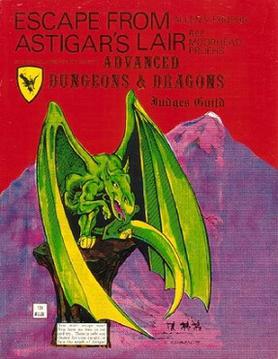
Escape from Astigar's Lair is an adventure for fantasy role-playing games published by Judges Guild in 1980.

Inferno is an adventure for fantasy role-playing games published by Judges Guild in 1980.

Portals of Torsh is a supplement for fantasy role-playing games published by Judges Guild in 1980.

Zienteck is an adventure for fantasy role-playing games published by Judges Guild in 1981.

The Book of Treasure Maps is a supplement for fantasy role-playing games published by Judges Guild in 1979.
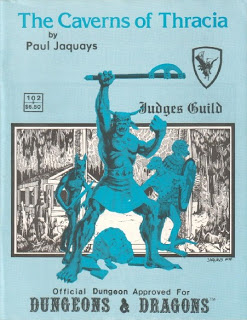
The Caverns of Thracia is an adventure for fantasy role-playing games published by Judges Guild in 1979. Written by Jennell Jaquays, it was compatible with Dungeons & Dragons. A revised edition—compatible with Dungeons & Dragons 3.5 edition—was published in 2004.
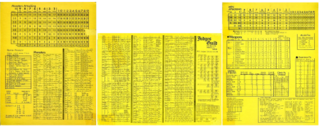
Judge's Shield is a gamemaster's screen created by Judges Guild in 1977 for the fantasy role-playing game Dungeons & Dragons, the first such screen to be published.
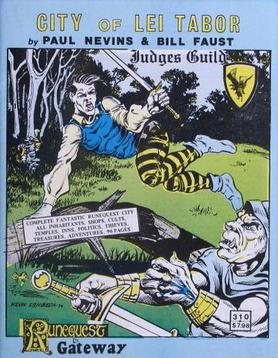
City of Lei Tabor is a 1980 fantasy role-playing game supplement published by Judges Guild for RuneQuest.
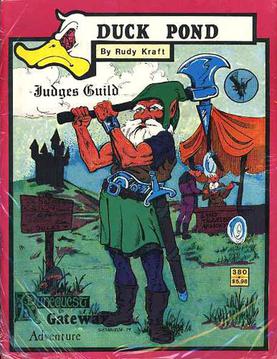
Duck Pond is a 1980 fantasy role-playing game adventure published by Judges Guild.
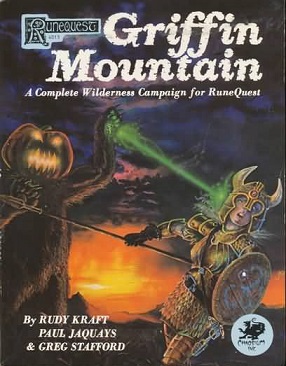
Griffin Mountain is a tabletop role-playing game supplement for RuneQuest, written by Rudy Kraft, Jennell Jaquays, and Greg Stafford, and published by Chaosium in 1981. Griffin Mountain is a wilderness campaign setting for the RuneQuest system, focussed on the land of Balazar and the Elder Wilds. It contains role-playing material to help gamemasters design adventures in the setting. It received positive reviews in game periodicals including Ares, White Dwarf, The Space Gamer, and Dragon.

Griffin Island is a boxed tabletop role-playing game supplement for RuneQuest. Originally published by Chaosium in 1981 as Griffin Mountain, a set of adventures set in the world of Glorantha, this edition was published in 1986 by The Avalon Hill Game Company as part of its third edition RuneQuest rules set. It was written by Rudy Kraft, Jennell Jaquays, Greg Stafford, and Sandy Petersen. Griffin Island contained role-playing material to help gamemasters design adventures in the setting. It received positive reviews in game periodicals including Casus Belli, White Dwarf, Dragon, Space Gamer/Fantasy Gamer, The Games Machine, and Games International.

The Lost Shrine of Kasar-Khan is an adventure published by Integrated Games in 1985 for fantasy role-playing games.